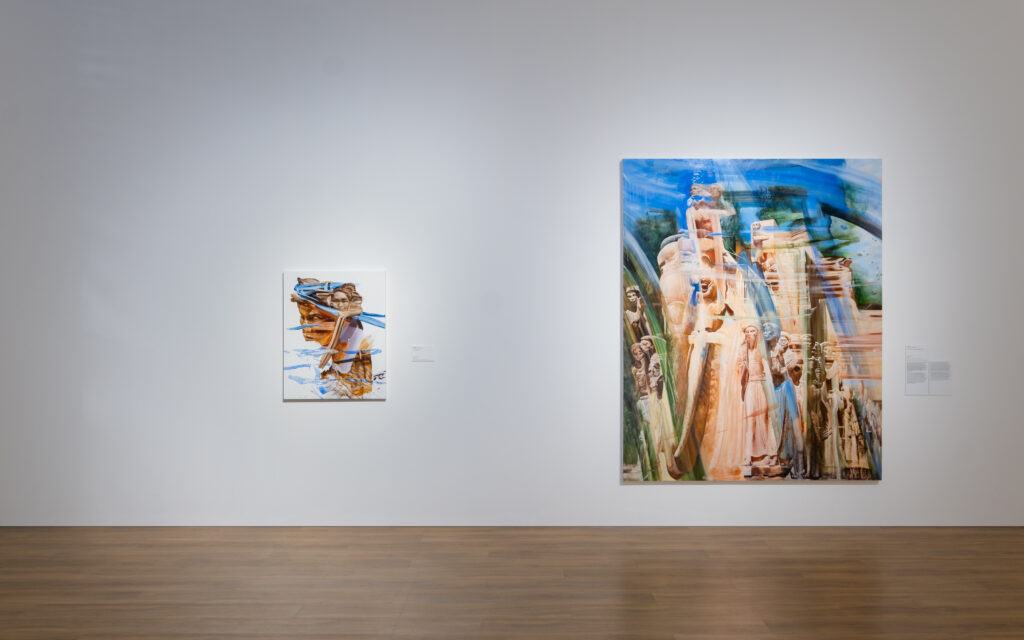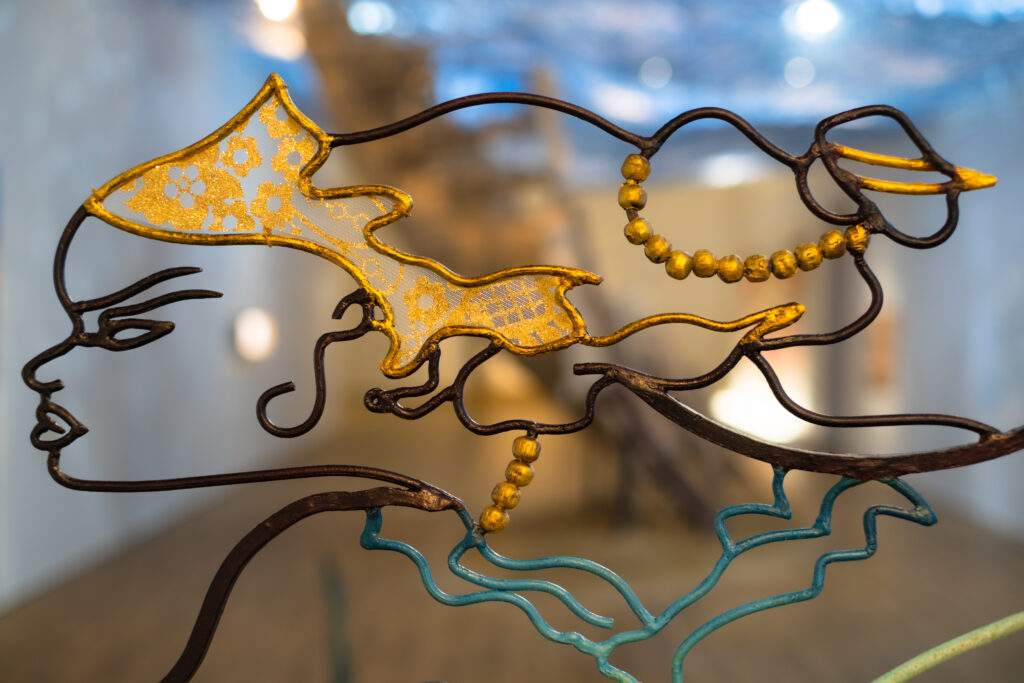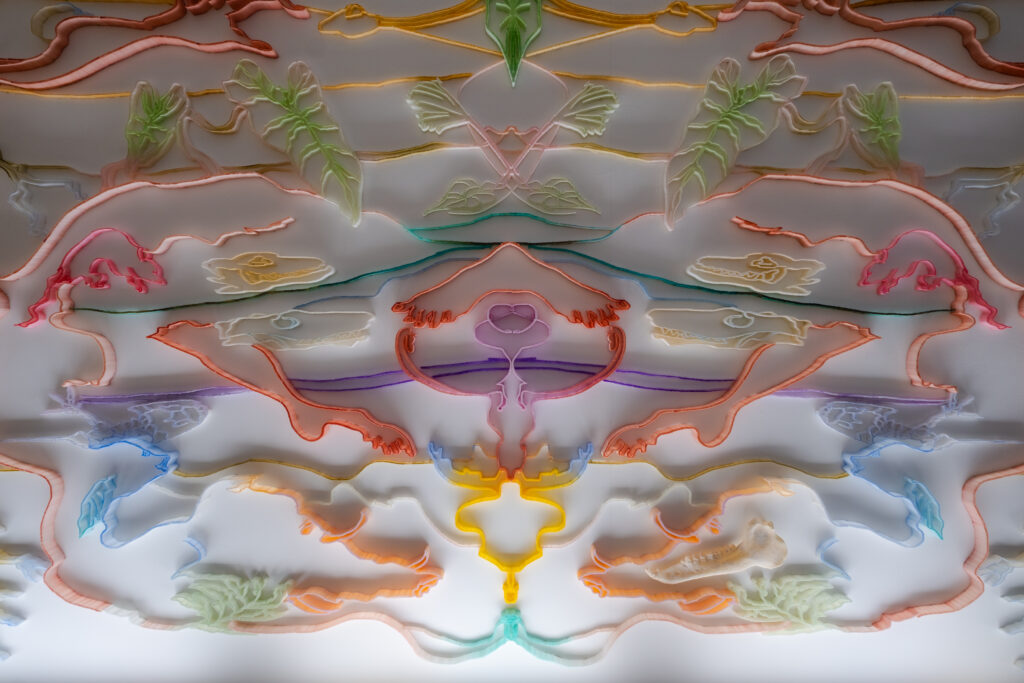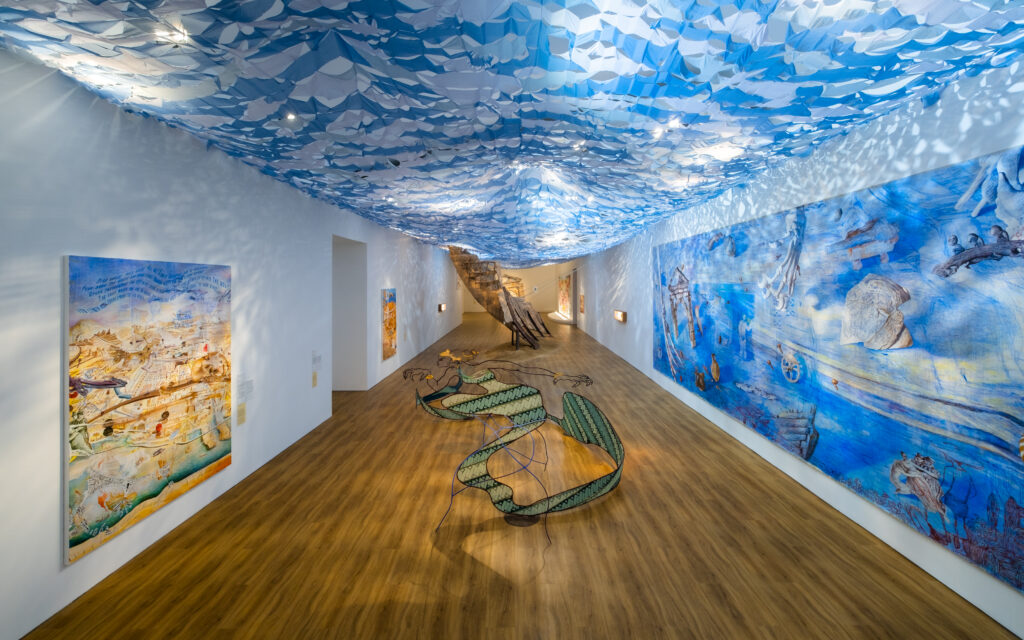“The Sea is Barely Wrinkled”: Interlace Between Sea and History Through The Eyes of Kei Imazu

Museum MACAN proudly presents “The Sea is Barely Wrinkled,” the first solo museum exhibition in Indonesia by renowned Japanese artist Kei Imazu, who is currently based in Bandung. This exhibition highlights Imazu’s evolving practice since she moved to Indonesia in 2018, marking a significant moment in her artistic journey. Featuring a series of newly-commissioned works, the show invites the audience to explore her unique visual language, which blends traditional painting with digital techniques and conceptual depth. Titled after the opening line of Italo Calvino’s 1983 Italian novel Mr. Palomar — “The sea is barely wrinkled”— the exhibition will be on view from May 24 to October 5 at Museum MACAN in Jakarta, Indonesia.

The Soul of The Work: Kei Imazu
Kei Imazu’s art practice merges traditional painting techniques with digital technologies. At the heart of her work is an exploration of overlapping timelines — interweaving human and non-human histories that are reimagined to challenge the boundaries between fact, myth, and fiction.
In 2025, Imazu presented her solo exhibition, “Tanah Air,” at Tokyo Opera City Art Gallery in Japan. Her recent exhibitions include “Bangkok Art Biennale: Nurture Gaia” (Bangkok, Thailand in 2024); “documenta fifteen” (Kassel, Germany in 2022); and “Mapping the Land/Body/Stories of its Past” (ANOMALY, Tokyo, Japan in 2021). Imazu was also a finalist for the Prix Jean-François Prat in 2020. She will also participate in two major group exhibitions in 2025: “Bukhara Biennial: Recipes for Broken Hearts” in Uzbekistan and the “Singapore Biennale: pure intention.”
Within Sea Depths And History’s Layers
The exhibition’s title is inspired by Mr. Palomar (1983), a novel by Italian writer Italo Calvino, in which the sea symbolizes both continuity and hidden depth — calm on the surface but teeming with invisible currents underneath. This mirrors Imazu’s approach to history, which she sees as layered and constantly shifting beneath what’s immediately visible.
Imazu’s work is rooted in extensive research into the Sunda Kelapa area of North Jakarta, a key maritime trading hub from pre-colonial times through the Dutch East India Company (VOC) era. A focal point of the exhibition is the 1629 shipwreck of the Batavia off the coast of Western Australia — a powerful symbol of colonial ambitions undone by the forces of nature. Imazu draws connections between this historical event and modern-day Jakarta, where environmental issues like flooding, land subsidence, and ecological instability continue to shape the city’s destiny.
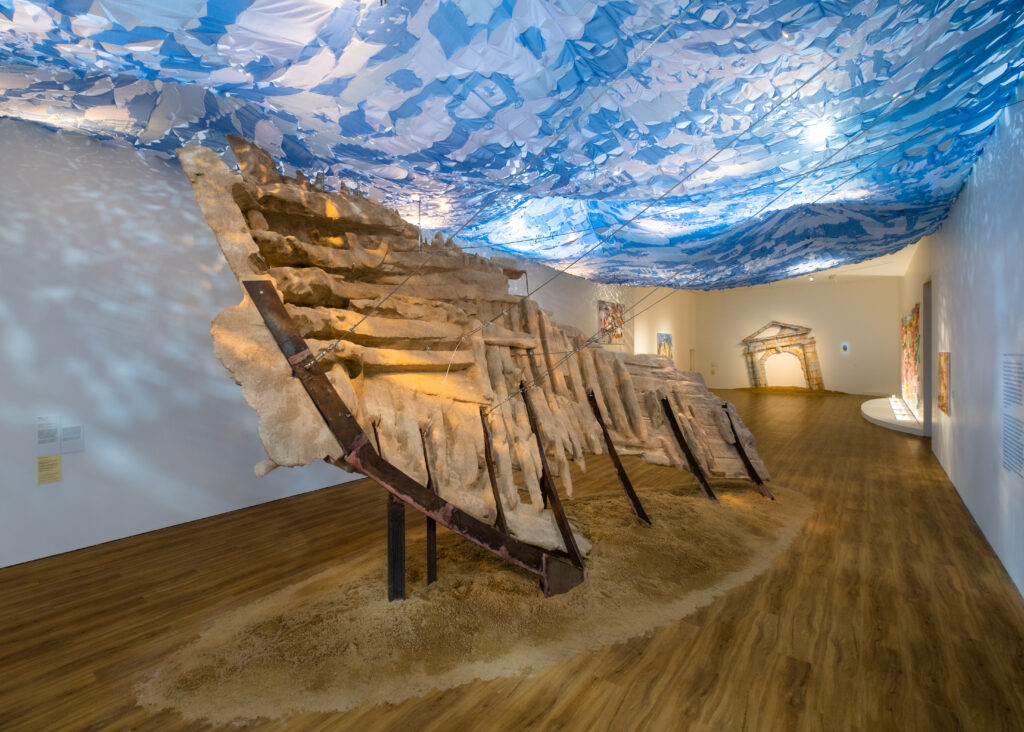
Variable dimension. Courtesy of the artist and ROH.
Installation view of Kei Imazu: The Sea is Barely Wrinkled at Museum MACAN.
In response to these interconnected themes, Imazu has developed what she calls a “time map,” a visual method that breaks away from conventional timelines to show how the past, present, and future are interwoven. Her art blends classical painting with digital techniques and 3D modeling — drawing from historical records, artifacts, and myths to explore the links between colonial history, environmental change, and urban growth.
Since moving to Indonesia in 2018, Imazu has been deeply influenced by the way local communities understand history. To them, history is not just something confined to the past, but is something that is a living, evolving presence kept alive through rituals, storytelling, and the natural world. Her artworks reflect this dynamic view, featuring mythological figures like Dewi Sri and Nyai Roro Kidul — goddesses that symbolize the spiritual ties between people, land, and sea.
Imazu finds it ironic and meaningful that the Batavia ship — an emblem of the Dutch East India Company — sank in the southern sea. According to local belief, Nyi Roro Kidul is the Queen of the Southern Sea, and the shipwreck symbolizes the wrath of the gods from the south, possibly explaining the loss of such a massive vessel at that time. On the other hand, Dewi Sri, the goddess of rice and fertility, is represented as a symbol of agrarian culture and the deep connection between society and the land.
Messages From Venus Lau And Kei Imazu
Venus Lau, Director of Museum MACAN, said in a press conference, “We are proud to present ‘The Sea is Barely Wrinkled,’ Kei Imazu’s first solo museum exhibition in Indonesia. Her work invites us to experience time and history as something fluid and alive, like the sea. Through her richly imaginative practice, she weaves together mythology, ecology, and memory in ways that feel both timeless and urgently relevant in our lives today. This exhibition offers the public a space to reflect on our deep, often-overlooked, relationship with the natural world and the layered history that shapes it.”
In the exhibition based on Imazu’s extensive research on the Sunda Kelapa area of Jakarta, the focus is on exploring Indonesia from a maritime perspective and highlighting the country’s relationship with the sea. This fresh viewpoint offers a different way to understand Indonesia’s identity and history. Venus Lau reflected on the oceanic theme by referencing the calm, barely wrinkled sea, evoking a deep, almost psychological connection to the ocean — this sets a contemplative tone, connecting literature, art, and history.
She stresses the importance of Jakarta’s history as a maritime city, reminding us that history writing and storytelling are crucial for understanding society. Through the lens of art history, we gain new perspectives on social and cultural identity. Ultimately, Venus Lau advocates for continuously rewriting and reinterpreting history, encouraging institutions and audiences to challenge traditional narratives and embrace diverse interpretations. This process keeps history alive and relevant, allowing art to be a dynamic tool in understanding our past and shaping our future.
Kei Imazu also stated, “I am deeply honored to present my first museum solo exhibition in Indonesia at Museum MACAN. It has been an incredibly enriching experience to explore Jakarta’s complex history and environmental issues through my artistic practice. Often, invisible or forgotten forces quietly shape our present realities. Myths possess the voice to communicate these unseen narratives, and I aimed to create an exhibition that gives form to that voice.”
Imazu also emphasizes that Jakarta is not just about historical events but also about folklore and traditions. Customs and local stories play a significant role in shaping how people live together and understand society.
During the opening week, Museum MACAN will offer a range of public programs, including a special guided tour and talk designed for children on Saturday, May 24, 2025. That same day, the museum will also present a talk titled The Sea is Barely Wrinkled: A Conversation with Kei Imazu. In this session, the artist will discuss the evolution of her creative practice, covering the materials and techniques she uses, as well as how her move from Japan to Indonesia in 2018 has transformed her perspective on history.
About Museum MACAN
The Museum of Modern and Contemporary Art in Nusantara (Museum MACAN) is a leading art museum located in Jakarta, Indonesia. It offers public access to an important and expanding collection of modern and contemporary art from both Indonesia and the global art scene. Housed in a 7100-square-meter space, the museum hosts a dynamic program of exhibitions and public events throughout the year.
Museum MACAN and Kei Imazu are both active on Instagram. Give their accounts a visit to get to know them more.
Curious about the annual art fair in Taiwan, Taipei Dangdai? Check out EnVi’s piece on their Taiwanese artist-focused exhibition titled “Pulling the Plug” here!
